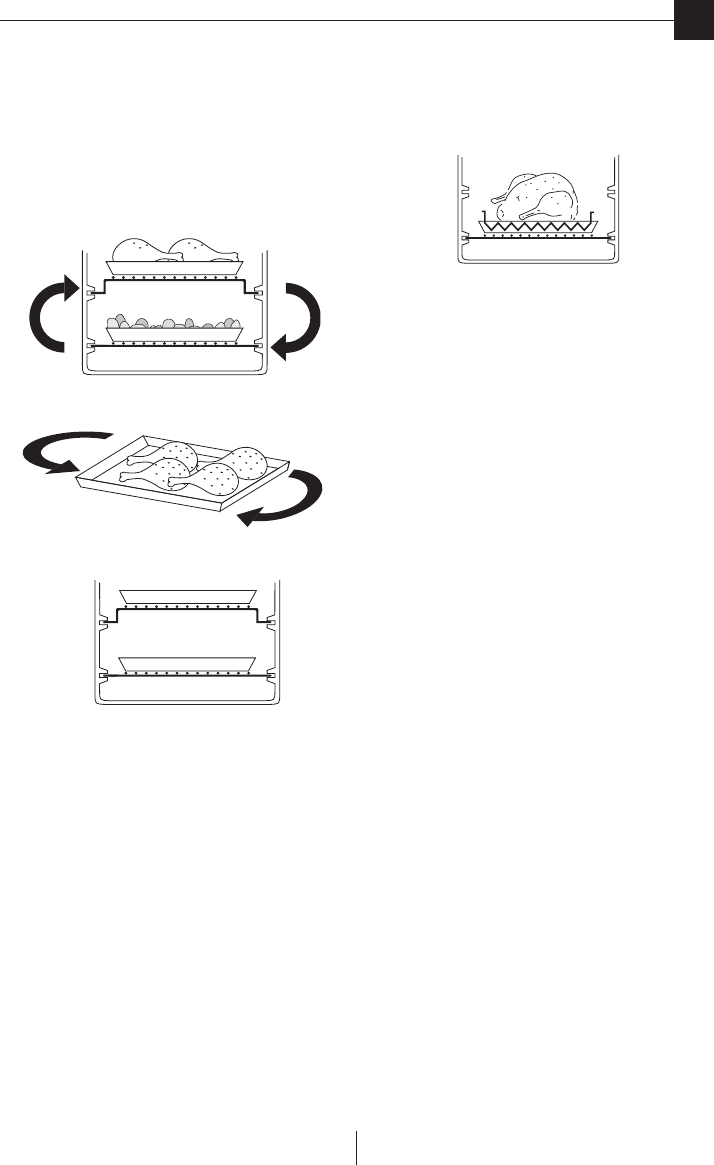
8
9
To cook two dishes at the same time, simply observe these ge-
neral rules.
1. The cooking times for dierent recipes prepared simulta-
neously are higher than when the items are cooked indivi-
dually.
2. Around halfway through cooking, change the position of
the 2 bake pans, placing the top one on the lower wire rack
and vice-versa.
In addition, turn the bake pans half-way around.
Note: the wire racks must be positioned as shown in the gure.
GENERAL GUIDELINES
With FAN & BAKE / DEFROST mode, a fan gently circulates the
heated air within the oven, providing a more even temperature
around the food. This system, used in many large commercial
ovens for years, produces more even browning and cooking of
baked foods, meats and poultry. The forced air also displaces
the layer of cold air surrounding the food, allowing faster co-
oking in many cases or a lowering of temperature. In general,
meats and poultry can be cooked in less time (a meat thermo-
meter will help to prevent overcooking). Cakes, pies, cookies,
etc. can be baked at a lower temperature (see charts).
BAKE mode is used when browning and crisping are less impor-
tant or undesirable. Use it, following conventional recipes, for
casseroles, stued vegetables, sh, lasagna, fruit tarts, cheese-
cakes and other moist mixtures.
Important : we recommend cooking chicken, roasts and small
fowl directly on the broiling rack resting on the bake pan (see
g.) to avoid fat spattering onto the sides of the oven and drip-
ping onto the bottom. See the following sections for further
details.
CONVECTION BAKING OF CONVENIENCE FOODS
Many convenience foods can be successfully baked or heated
by convection on the FAN & BAKE / DEFROST mode. In gene-
ral, follow the package directions for temperature and time.
However, lower the temperature by 25°F. There is such a wide
choice of convenience foods on the market and variations in
packaging, quantities and initial temperatures (frozen, refrige-
rated and shelf temperature) that it’s best to follow the package
instructions. Check the food 5 to 10 minutes before the time is
up;youmayneedtoadjustthetimeand/ortemperaturefor
best results.
Here are some tips for dierent types of conve-
nience foods:
• Ifdirectionscallforplacingthefoodcontaineronametal
pan to avoid spills or to aid even cooking, use the bake pan
provided. Use it for foods, such as rolls, cookies, turnovers
or frozen French fries, breaded sh or chicken pieces, that
are placed directly on a pan.
• Somefrozenfoodscomein“oven-proof”plasticorpaper
containers which can be cooked in a microwave oven and,
within limits, a conventional oven. Be sure to follow direc-
tions for maximum baking temperature. The container can
melt or scorch if too high a temperature is used. To be on
the safe side, set the oven 25°F lower than the recommen-
ded temperature.
• When baking packaged mixtures (such as scalloped
potatoes, macaroni and cheese, brownies, corn bread,
coeecake and cake mixes) check the package directions
for recommended sizes of pan, casserole or dish and the
proper baking times for each. A 9-inch round or an 11 x
7 inch rectangular pan will t in the oven with room on
all sides for air circulation. Layer cake mixes can be baked
one layer at a time in a 8- or 9-inch round pan or all of the
batter in a 3-inch deep 9-inch round bundt or spring-form
pan.
en


















